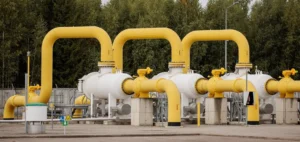The global liquefied natural gas (LNG) market is gearing up for a difficult few months, even though gas stocks in Europe are currently high.
As of August 28, European reserves stood at 91.98% of capacity, well ahead of the 90% target set by the European Union for November 2024.
This solid position could offer some cushion against supply shocks, but the market remains vulnerable.
The situation is exacerbated by uncertainties regarding Russian gas flows via Ukraine, still at around 42 million cubic meters per day.
The expiry of the gas transit agreement between Russia and Ukraine, scheduled for January 2025, has market players worried.
An interruption in Russian flows through Ukraine before the end of the agreement could force Europe to increase its LNG imports to compensate, creating further pressure on an already tight market.
Demand from Asia and Latin America, combined with these possible disruptions, could lead to significant imbalances.
Currently, the price differential between the Japan-Korea Marker (JKM) and the Northwest European marker (NWE) for January 2025 is the widest on the futures curve, showing that Asian buyers are preparing for increased competition for available cargoes.
Hedging strategies and hedge fund movements
Hedge funds continue to play a major role in the European gas and LNG markets.
According to recent data from the Intercontinental Exchange, these funds account for around 22% of total European natural gas futures positions . This significant presence reflects players’ caution in the face of market uncertainties, notably delays in the development of new LNG liquefaction capacity, which could further tighten global supply in 2024 and early 2025.
In response, some market players are considering bringing forward cargo deliveries for these periods to secure supplies at more stable prices.
Discussions about these early deliveries show that buyers are seeking to avoid winter spot price fluctuations, which could be exacerbated by unforeseen supply interruptions.
Producers, for their part, favor the signing of Brent-indexed futures contracts, offering revenue visibility in a volatile environment.
Uncertainties over infrastructure and geopolitics
Beyond the tensions between Russia and Ukraine, other challenges persist with regard to supply infrastructures.
Algeria, which accounts for a significant proportion of gas exports to Europe, is experiencing periods of fluctuating gas flows, raising concerns about its reliability as a supplier.
In Norway, maintenance work scheduled for several gas fields at the end of the year could temporarily reduce available volumes.
Similarly, the postponement of maintenance on the Gela pipeline, linking Libya to Italy, from September to October, suggests that supply conditions could be tighter than expected.
Market players are also keeping an eye on recent geopolitical events.
Russia’s attacks on Ukrainian energy infrastructure, including gas compressor stations, drove up prices in Europe this week.
Although these attacks have not yet had a direct impact on gas flows to Europe, they highlight the vulnerability of the infrastructure and the ongoing risk of escalating disruptions.
Demand prospects and price volatility this winter
Winter weather forecasts and maintenance operations on European gas infrastructures add further uncertainties.
After two mild winters, a harsh winter could sharply increase gas demand, making markets even more sensitive to shocks.
Market analysts point out that European prices have already shown their volatility this year in response to geopolitical and technical factors.
Particular attention is being paid to planned maintenance on Norwegian gas fields, as any extension or complication could further restrict supply, especially at the start of the cold season.
Movements on Asian markets reflect this anticipation of uncertainty.
Buyers in South Korea, for example, are already negotiating advanced cargoes for winter and early 2025.
Although Indian buyers are not yet as active, they could adopt a similar strategy if spreads between futures and spot prices remain significant.
Discussions about bringing forward deliveries suggest that caution is called for in the face of demand forecasts and the risk of price volatility.






















